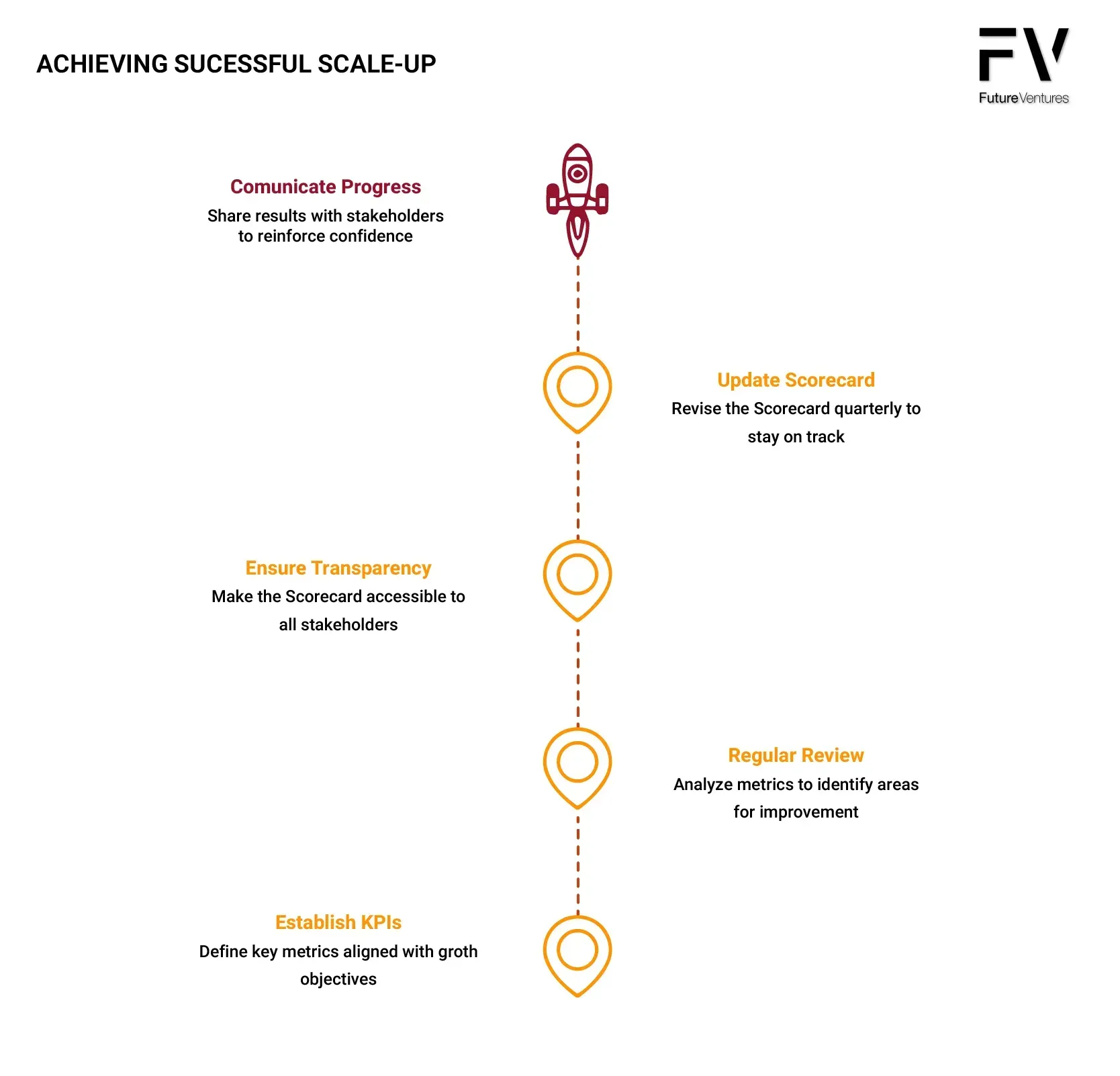Mastering the Scale-Up Strategy Essential Tips for Sustainable Growth
Scaled business growth isn’t a linear race—it’s a survival game where the rules change faster than TikTok trends. The difference between scaling and dying often comes down to ruthless prioritization, talent density, and avoiding what I call “scale-up vertigo” (more on that later). Let’s break this down like a profit-and-loss statement.
Understanding the Scale-Up Journey: It’s Not a Sprint, It’s a Relay
Well-defined strategies are critical in achieving growth and reaching scaleup status. These strategies should encompass clear goals, focus areas, and measurable actions, distinguishing effective planning from vague aspirations.
The 3 Phases of Scale-Up Pain:
- Survival Mode (0-$10M revenue): Focus on product-market fit. Think Tinder’s early days—swipe right on your core audience or die lonely.
- Hypergrowth ($10M-$100M): Scaling processes and systems become your God. This is where Uber ate taxis by obsessing over unit economics.
- Maturity ($100M+): Innovation vs. bureaucracy cage match. Blockbuster lost this fight; Netflix won. Even though Blockbuster both had the opportunity to buy Netflix and was developing a similar model that was impeded by the desire to self-disrupt.
Companies that scale up successfully are able to adapt to changing market conditions and stay ahead of the competition.
Key Metric: If your CAC payback period grows faster than your revenue, sound the alarms.
Building a Strong Foundation: Laying the Groundwork for Success
Building a strong foundation is the bedrock of a successful scale-up. Think of it as constructing a skyscraper; without a solid base, the entire structure is at risk of collapsing. Business leaders must start by establishing a clear vision, mission, and set of core values that will guide every decision and action within the company. This clarity not only aligns the whole team but also sets the stage for exponential growth.
A well-defined strategy is essential for achieving this growth. Enter the One Page Strategic Plan (OPSP)—a powerful tool that distills your winning strategy into a concise, actionable format. This is your Business Model Canvas. This plan ensures that everyone in the company is on the same page, driving towards the same goals. Many start-ups falter in their scale-up journey due to a lack of planning, poor execution, and inadequate support systems. By contrast, a strong foundation, built on a deep understanding of the company’s strengths, weaknesses, opportunities, and threats (SWOT analysis), can set the stage for success.
Moreover, a strong company culture is indispensable. It attracts and retains top talent, drives innovation, and fosters a sense of belonging and purpose. Business leaders must be adaptable and willing to pivot when necessary, as the scale-up journey is often unpredictable and fraught with challenges. By laying a strong foundation, business leaders can set their companies up for long-term success and achieve their growth goals.
Crafting a Winning Strategy: Your One-Page “Death Star Plan”
Forget 50-page decks. If your strategy doesn’t fit on a page, you’ve already failed. Why? A one-page strategic plan or business canvas can help you, as the business leaders, clarify your vision and goals and communicate them to the whole team. Everyone in the chain of command has to be absolutely clear on the North Star and the strategy that the company is pursuing. A good strategy should be focused on the core values and mission of the company and should be aligned with the company’s overall vision. A good indicator that your scaling-up strategy is on point is when you start saying ‘No’ more than you are saying ‘Yes.’
The Scale-Up Strategy Matrix
| Element | Startups (< $10M) | Scale-ups (>$10M) |
|---|---|---|
| Focus | Product obsession | Process obsession |
| Risk Tolerance | High (gambler mindset) | Calculated (chess master) |
| Hiring Priority | General athletes | Specialist ninjas |
| Cash Burn | Acceptable | Existential threat |
Example: Slack’s pivot from gaming to SaaS was a strategic neutron bomb—they kept the chat tech that worked and torched the rest. The product that they had developed internally to help them communicate better became the Product around which the company organized.
What Are the 4 Pillars of Scaling Up?
Scaling up isn’t about doing more—it’s about doing better in four non-negotiable areas. Borrowed from Verne Harnish’s battle-tested framework, these pillars separate the rocketships from the wreckage:
| Pillar | Focus | Key Actions |
|---|---|---|
| People | Talent density + culture | Hire A-players, build accountability, kill ego-driven politics and get rid of yes-sayers |
| Strategy | Ruthless prioritization | Create a one-page plan, dominate a niche, say “no” to shiny objects |
| Execution | Daily rhythm of accountability | Implement OKRs, daily huddles, and RACI matrices |
| Cash | Oxygen for growth | Track burn rate like a hawk, negotiate 90-day terms, diversify funding |
Companies that have successfully scaled up by focusing on these four pillars have significantly contributed to economic growth and job creation.
Why This Works:
- The Talent Density Rule: Jeff Bezos’ “two-pizza team” rule wasn't about carbs— but about finding the right balance between diversity of thought and velocity. Your #1-20 hires will determine 80% of outcomes. Senior leaders recognize they have established an organization capable of scaling when they are not present to direct activities. Yet, the team understands how to move forward to achieve strategic outcomes.
- The Culture Litmus Test: If your values doc reads like a UN resolution, you’ve failed. Shopify’s “Knights, Merchants, Sherpas” framework worked because it meant something. Companies that scale up successfully are able to build a strong foundation that supports their growth and helps them to stay ahead of the competition. A well-functioning team is crucial for scaling a business.
- The Long Game Test: With the sudden arrival of the COVID-19 pandemic in 2020, 85% of Airbnb’s bookings were canceled overnight. However, their response to the pandemic has become legendary, studied by academia and organizations. In an effort to avoid bankruptcy, they had to do everything possible to preserve cash, cutting 25% of their staff and focusing intently on core revenue. They approached these challenges with heart and a long-term mindset. They assisted their departing colleagues in finding new opportunities, maintained health benefits, and provided access to Airbnb properties for essential workers, creating significant enduring goodwill and brand value.
What Is the Scaling Up Method?
The Scaling Up method is Verne Harnish’s playbook for turning growth from chaotic to systematic. Think of it as business judo—using momentum to scale without imploding.
A key component of this method is the implementation of well-defined strategies that transform chaotic growth into systematic growth.
The 3-Step Growth Formula
1.Decisions (The “What”)
- Lock in your Big Hairy Audacious Goal (BHAG)
- Choose between being a Cost Leader (Walmart) or Differentiator (Apple)
2.Disciplines (The “How”)
- Daily huddles (under 15 minutes)
- Weekly leadership syncs with red/yellow/green KPIs
3.Catalyst (The “Who”)
- Turn managers into coaches (Microsoft’s “growth mindset” overhaul added $1T in value)
Phase-Based Scaling
| Revenue Phase | Focus | Killer Risk |
|---|---|---|
| $0-$10M | Product obsession | Running out of cash (82% fail here) |
| $10M-$100M | Process obsession | Founder’s ego vs. systems |
| $100M+ | Culture carrier | Innovation complacency (RIP Blockbuster) |
Tools of the Trade:
- One-Page Strategic Plan: Slack’s pivot from games to SaaS fit on a napkin
- SWOT on Steroids: Tesla’s 2019 “threat matrix” predicted chip shortages 18 months early
- Cash Flow Ninja Moves: Netflix’s shift from DVD margins to subscription liquidity
⚠️ Warning: Scaling Up ≠ scaling fast. It’s scaling right—the method forces you to sweat the 20% that drives 80% of results.
Integration Tip: Weave these pillars into your existing strategy like Tesla’s Autopilot—always on, course-correcting in real time.
Achieving Exponential Growth: Lighting the Flywheel
Exponential growth isn’t luck—it’s physics. Exponential growth is a key characteristic of successful scale-ups. Business leaders should focus on achieving exponential growth by identifying and leveraging key drivers of growth. Companies that have scaled successfully often focus on these key drivers to increase their size and impact significantly.
Do you have an Opportunites Management Framework in place? Have you defined all of your Drivers and Improvement Levers in an Enterprise Value Map?
Do you have a Capital Allocation framework that prioritizes the areas of highest growth potential?
⚠️ Warning: If your responses to the previous questions are not a resounding “Absolutely!”, it might be time to seek assistance.
CTA: We invite you to a no-obligation consultation to explore how we can collaboratively create a Growth and Value Drivers Assessment.
The 5-Force Flywheel
- Acquisition: Paid ads are cocaine—great short-term, deadly long-term. Dollar Shave Club produced a viral video for $4,500, which helped create a $1 billion brand and ultimately led to its acquisition by Unilever in 2016.
- Activation: Reduce friction like Tesla removing dealerships.
- Revenue: Tiered pricing is your friend. See: Salesforce’s stair-step model.
- Referral: Dropbox’s “free storage for friends” hack grew users 60x in 15 months.
- Retention: Amazon Prime’s 93% renewal rate isn’t magic—it’s calculated addiction.
Companies that achieve exponential growth can stay ahead of the competition and attain long-term success. This also involves the systematic identification of new markets, the development of new products and services, and the establishment of strategic partnerships.
Focus and Prioritization: The Eisenhower Matrix on Steroids
Scale-ups die from distraction, not competition.
The Impact/Effort Matrix for Leaders
| High Impact | Low Impact | |
|---|---|---|
| Low Effort | Do immediately | Delegate/automate |
| High Effort | Schedule deep work blocks | Eliminate ruthlessly |
Pro Tip: If it doesn’t move ARR or NPS, it’s a hobby—not a priority.
Leadership and Team Development: From Founders to Force Multipliers
The CEO’s role evolves faster than a TikTok dance trend:
Leadership Phase Shifts
- $0-$10M: Visionary cheerleader
- $10M-$100M: System architect
- $100M+: Culture carrier
The Talent Density Matrix
| High Potential | Low Potential | |
|---|---|---|
| High Performers | Future executives (invest heavily) | Plateaued stars (manage out) |
| Low Performers | Growth projects | Immediate exits |
Case Study: Microsoft’s “growth mindset” overhaul under Satya Nadella added $1T in market cap.
Execution and Accountability: The RACI Nuclear Codes
RACI Matrix for Scale-Ups
| Role | Responsibility |
|---|---|
| Responsible | The Navy SEALs executing the mission |
| Accountable | The president who loses sleep over nukes |
| Consulted | The advisors who’ve seen this movie beforendice |
| Informed | Everyone else (keep updates concise) |
Data Point: Companies using OKRs (like Google) grow 3x faster than those relying on vague KPIs.
Overcoming Common Challenges: The Scale-Up Kill List
Scaling up a business is not without its challenges, and business leaders should be aware of the common obstacles that they may face. This includes managing cash flow, navigating different geographies, and staying ahead of the competition. Companies that are able to overcome these challenges are able to achieve their goals and stay ahead of the competition. Scaling requires strong communication, regular schedules, meetings, and checkups.
Additionally, well-defined strategies are crucial in overcoming these challenges, as they provide clear goals, focus areas, and measurable actions that align with the company’s vision and mission.
Top 5 Scale-Up Killers
- Cash Flow Cancer: 82% of failures trace here.
- Founder’s Paradox: The skills that built the startup often destroy the scale-up.
- Process Anemia: Scaling without systems is like building IKEA furniture without instructions.
- Culture Dilution: New hires per month >50? You’re now a cultural blender.
- Innovation Complacency: The “If it ain’t broke” mentality broke Sears.
SWOT Analysis for Scale-Ups
| Strengths | Weaknesses |
|---|---|
| First-mover advantage | Technical debt |
| Opportunities | Threats |
| Emerging markets | Regulatory shifts |
Measuring and Evaluating Progress: The Scale-Up Scorecard
Measuring and evaluating progress is the compass that guides a successful scale-up. Without it, business leaders are navigating in the dark. The Scale-Up Scorecard is an invaluable tool for tracking performance, identifying areas for improvement, and making data-driven decisions that propel the company forward.

To start, business leaders must establish clear key performance indicators (KPIs) and metrics that align with their growth objectives. These might include revenue growth, customer acquisition, customer retention, and employee engagement. Regularly reviewing and analyzing these metrics allows leaders to pinpoint what’s working and what needs adjustment.
Transparency and accountability are crucial. The Scale-Up Scorecard should be accessible to all stakeholders, ensuring everyone understands the company’s progress and challenges. This openness fosters a culture of trust and collective responsibility.
The Scorecard should be reviewed and updated regularly, ideally on a quarterly basis. This ensures that the company remains on track to achieve its growth goals and can quickly adapt to any changes in the market or internal dynamics. By using the Scale-Up Scorecard, business leaders can make informed decisions, drive growth, and achieve success.
Moreover, the Scorecard is a powerful communication tool. It provides a clear snapshot of progress and results to investors, customers, and employees, reinforcing confidence and commitment. By measuring and evaluating progress regularly, business leaders can ensure their companies are on the path to a successful scale-up, navigating the complexities of growth with precision and confidence.
Scaling for Long-Term Success: Becoming a Category King
Sustainable scale isn’t about being the biggest—it’s about being indispensable. Companies that have scaled successfully to become category kings, like Amazon and Google, demonstrate the importance of this approach.
The 3 Laws of Category Kings:
- Own a mental category (Zoom = video calls)
- Monetize through ecosystems (Apple’s 30% App Store tax)
- Innovate at the speed of paranoia (Netflix pivoting 4x in 20 years)
Conclusion
Scaling is 10% strategy, 90% execution. The companies that win are those where every employee can recite the playbook blindfolded—but still improvise like jazz musicians when the market shifts. Your move!










